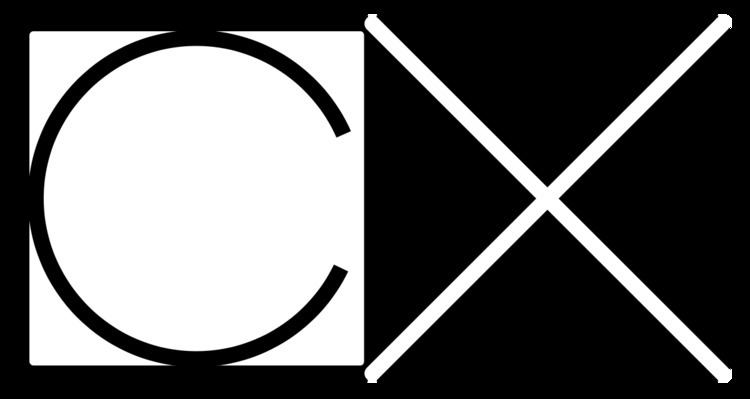 | ||
CX is a noise reduction system for recorded analog audio. It was developed by CBS Laboratories (a division of CBS) in the late 1970s as a competitor to other noise reduction (NR) systems such as Dolby and dbx, and was officially introduced in 1981. The name CX was derived from "Compatible eXpansion," a feature of the technique. The CX integrated circuit U2141B was developed by AEG-Telefunken, Germany, in 1982, by the same team who also designed the High Com noise reduction system, a broadband compander with typically up to 20 dB of noise reduction (and more).
Contents
Use on Vinyl LP records
CX was originally designed by CBS as a noise-reduction technology for vinyl LP records, similar to the earlier dbx system for dbx discs. CX required a special decoder connected to a stereo system, in order to fully reproduce the CX encoded sound on the LP. However, CX-encoded records could also be played without a decoder, with a resulting (claimed acceptable) amount of dynamic range compression. Relatively few hardware decoder boxes were sold.
The project was led by CBS Records group vice president Bob Jamieson and carried out by a team led by Dan Graveraux. The label predicted that CX encoding would become standard on all new LP releases but this did not happen. CBS struggled to gain support for the system from other record companies. The process was controversial among CBS executives and unpopular with some artists. Classical guitarist Liona Boyd demanded that the CX encoded version of one of her albums be withdrawn because of perceived shortcomings, even though Jamieson claimed that CBS had the technical means to overcome such objections.
Approximately 70 CX encoded LP titles were released by CBS in 1982 in the United States. In Europe many CX discs were manufactured in the Netherlands with the catalog number prefix "CBSCX". The albums in this series also came in standard, non CX encoded versions.
Use on LaserDisc
While the implementation of CX with LP's was quite unsuccessful and short-lived, CX would later see success as the NR used for the stereo analog audio tracks on the LaserDisc format. It was also used for the audio tracks on discs of the RCA SelectaVision CED Videodisc system.
All LaserDisc (and stereophonic CED) players manufactured since 1981, when the CX equipped LD-1100 was introduced, had CX NR capability as a standard feature. Pioneer also released a stand-alone CX adapter for use with their VP-1000, Magnavox's VH-8000/8005 and the industrial players that were all released before CX was adopted. The first CX encoded LaserDisc was "Olivia Newton-John: Physical" on the MCA Videodisc label.
CX decoders made for LP's could not be used with LD's because the CX companding specifications for LaserDisc were changed, from 20 dB of noise reduction to 14 dB, along with moving the 'threshold' where compression/expansion changes from 2:1 to 1:1 from -40 dB to -28 dB - other minor changes to the decoding time constants were made as well. In addition, some of the LaserDisc's FM audio encoding specifications were modified too, allowing more headroom and better high frequency response at high levels. These changes were made because, at the time of CX's adoption on LaserDisc (1981), the vast majority of program sources used for mastering, such as 35mm optical and magnetic film soundtracks, as well as the 2-inch IVC-9000 and the 1-inch C-Type video tape formats used for LaserDisc mastering, had signal-to-noise ratios low enough that undecoded playback would accentuate their noise to unacceptable levels.
By reducing the total amount of noise reduction and modifying other aspects of the CX system to better match LD's FM audio shortcomings, undecoded playback sound quality was maintained and vastly improved decoded sound was achieved at the same time. The possibility of audible pumping or breathing artifacts during CX decoded playback were reduced as well.
While CX greatly improved the audio quality of LaserDisc's FM audio tracks, its primary reason for adoption was to decrease the amount of interference between the right channel's FM audio carrier and the video carrier's first chroma sideband. Without CX, strict filtering during mastering and playback as well as keeping color saturation below 75% on the master were required to keep any interference below -35db, which ensured that no beats or other artifacts were visible in the demodulated image. Although CX improved the picture quality, it was not normally used on discs with mono audio. Pioneer Video, the main manufacturer of LD's at the time, required the studios to request CX and, since most did not know that CX improved the video quality of the finished discs or the audio of mono titles, CX was rarely requested. Due to this lack of knowledge about CX at the studios, there were many stereo titles released without CX encoding and, in fact, CX didn't become standard on all LaserDisc titles until the late 80's. A look at Pioneer's catalogs as late as 1987 shows that the majority of titles did not have CX encoded analog sound - most were not digital either.
For the CED VideoDisc, since stereo was not added to the format until its second year on the market, RCA made CX a mandatory part of CED's stereo system - a disc could not be released in stereo without CX encoding - and the companding specifications were unchanged from those of the LP system due to the CED system's much higher noise levels than the LaserDisc format. Although RCA improved the plastic/carbon formulation used to make discs, which lowered disc noise levels by 3db, and modified the mastering system, the CED format still required the full 20 dB of noise reduction that was achieved with the unmodified LP system. The names given by CBS to the two different versions of CX were CX-20 and CX-14.
The theory of operation is described in U.S. Patent 4,376,916.
